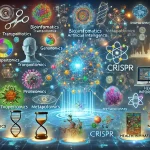
Navigating the Complexities of Genomic Data Analysis: A Comprehensive Guide for Students
August 19, 2023The explosion of genomic data in recent years has been nothing short of monumental. Behind every sequence, there’s a promise of a novel discovery, a better understanding of life’s intricacies, or answers to age-old biological conundrums. For students eager to tap into this vast reservoir of information, the path might seem challenging but equally rewarding. Let’s delve deep into the fascinating world of genomic data analysis and uncover its myriad aspects.
1. Embarking on the Genomic Journey: Why It Matters
Genomics is more than just sequences of adenine, thymine, cytosine, and guanine. It’s about interpreting these sequences, understanding the story they narrate about evolution, disease, physiology, and so much more. As students, stepping into genomics is like becoming a part of a revolution – a shift in how we perceive biology at its most fundamental level.
2. Building a Solid Foundation: The Basics of Genomics
Before one dives into data analysis, there’s merit in understanding the data itself. Genomes are complete sets of DNA in an organism, including all its genes. Every species has its own unique genome, and the differences in sequences play a pivotal role in biodiversity. Familiarizing oneself with genomic terminologies, structures, and basic concepts will serve as the bedrock for all subsequent analytical endeavors.
3. The Breadth and Depth of Genomic Data
Genomic data isn’t singular in its nature. From whole-genome sequencing to exome sequencing, from single nucleotide polymorphisms (SNPs) to large structural variations, the data can be multifaceted. Each dataset offers a distinct lens through which to view the vast genomic landscape. Deciding which data to work with largely depends on the research question at hand.
4. Essential Tools and Platforms for Genomic Analysis
The toolkits available for genomic analysis are myriad. For sequence alignment, tools like Bowtie and BWA are indispensable. For variant calling, GATK and Samtools have set industry standards. Platforms such as Galaxy provide an integrated environment for a multitude of genomic data analysis tasks, streamlining the process for both novices and experts.
5. Challenges in Genomic Data Analysis
Like any analytical domain, genomics comes with its own set of challenges. The sheer volume of data can be overwhelming. Moreover, ensuring data quality, handling missing data, and accounting for biases are crucial for obtaining meaningful insights.
6. Practical Steps in Genomic Data Analysis
Once you have your genomic data and a clear research question, a general workflow might look like this:
- Data Preprocessing: Before any meaningful analysis, raw data needs refining. This includes quality checks, filtering, and sequence alignment.
- Variant Calling: Post alignment, the next step is identifying variants – spots where the sequenced genome differs from a reference genome.
- Annotation and Interpretation: After identifying variants, annotate them. This means understanding the potential implications of these variants, be it in terms of disease predisposition or any other trait.
- Visualization: Tools like IGV or UCSC Genome Browser allow a graphical representation of the analyzed data, making it easier to interpret and present.
7. Real-world Applications: Making Sense of the Data
From personalized medicine to evolutionary biology studies, genomic data analysis paves the way for tangible real-world applications. For instance, understanding genetic predispositions can help in tailoring medical treatments suited to individual patients.
8. Beyond Analysis: Ethical Considerations
Genomic data is deeply personal. As budding analysts, it’s essential to understand the ethical implications of data handling, storage, and sharing. Ensuring privacy, obtaining informed consents, and maintaining transparency in research are non-negotiable.
9. Continual Learning: The Genomic Field is Ever-evolving
Given the rapid advancements in genomics, what’s state-of-the-art today might be obsolete tomorrow. Subscribing to journals, attending conferences, and being part of academic forums will ensure that you’re always at the forefront of the latest developments.
10. Engaging with the Community: Collaborate and Learn
Interacting with the broader genomics community can provide valuable insights. Whether it’s troubleshooting a software issue, understanding a peculiar dataset, or brainstorming research ideas, the collective wisdom of the community is an invaluable asset.
Conclusion
The universe of genomic data analysis is vast, intricate, and ever-expanding. For students setting foot in this realm, the journey is bound to be transformative. With each sequence analyzed, with each variant identified, you’re not just crunching numbers – you’re adding to our collective understanding of life. And while the road might seem daunting at times, remember that with every challenge comes an opportunity – an opportunity to learn, to discover, and to contribute to the grand tapestry of genomics.


















